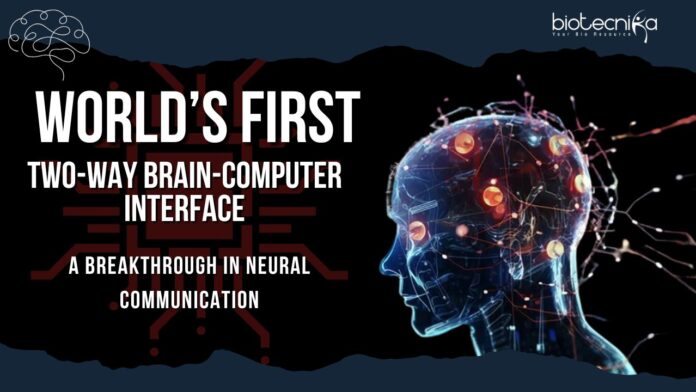Two-Way Brain-Computer Interface – A Breakthrough in Neural Communication
Imagine a future world where the boundaries between human thought and machine action fade, where controlling complicated devices is as effortless as thinking! This vision is eventually becoming a reality, all thanks to the innovative research from Tsinghua University and Tianjin University.
They have revealed the world’s first two-way adaptive BCI (Brain-Computer Interface). This historic achievement was reported in Nature Electronics and was highlighted by the South China Morning Post. This system is powered by an innovative memristor-based adaptive neuromorphic decoder. It does not just read the brainwaves, but it advances a dynamic & two-way dialogue between mind and machine. This aided in achieving a 100-fold increase in efficiency and a 1,000-fold reduction in energy consumption compared to conventional BCIs. It also empowers users with four degrees of freedom in movement control, promising a new era of brain-computer co-evolution.
The 128k-cell Memristor Chip
At the heart of this innovation is a 128k-cell memristor chip, a testament to the power of neuromorphic computing. These memristors mimic the synaptic plasticity of the human brain and retain the information even when power is off, unlike the traditional silicon-based processors.
This helps a hardware-efficient one-step decoding strategy as well as streamlines the complicated process of translating neural signals into valid and actionable commands. However, the main character of this system lies in its dual-loop feedback mechanism. It is designed to nurture a symbiotic relationship between users as well as machines.
- The Adaptive Decoding Loop: Powered by advanced ML (Machine Learning) algorithms, this loop regularly refines the brain wave decoder. It learns from the user’s neural patterns and adapts in real-time to optimize responsiveness and decoding accuracy. This powerful adaptation is essential for overcoming reliable performance, the inherent variability of our brain signals, and ensuring consistency.
- The User Calibration Loop: Providing visual feedback to the system allows users to learn actively, refine their thought patterns, and enhance their control over BCIs. This interactive approach builds a deeper connection between the mind and machines, transforming users from being passive observers to becoming active collaborators.
Intuitive Control & Fluid Movement
This powerful mechanism’s implications are very clear in the system’s enhanced controls, as it enables users to control virtual objects with great fluidity. This shows a 20% increase in accuracy when compared to the conventional BCIs, representing the system’s ability to translate and decode neural signals with enhanced precision.
Imagine having control of a virtual drone as effortlessly as moving your hand. This level of intuitive control opens up a new horizon full of possibilities. It does not apply just to virtual environments but also to real-world applications.
For example, in the medical field, this futuristic technology could be utilized to control assistive devices or robotic prosthetics for people with physical disabilities. In the field of gaming, it could transform the way we interact with virtual environments. The potential for seamless interaction with external devices and AI systems is immense, paving the way for more natural and intuitive human-machine collaborations.
Effects Beyond The Laboratory
This extraordinary innovation extends beyond the research laboratory, providing hope for individuals with neurological illness in the Medical field. Imagine restoring the motor function of those people paralyzed by spinal cord injuries or stroke, as well as providing new innovative ways for communication to those with severe speech disorders.
The system’s portability and low energy consumption make it ideal for consumer applications and wearables, aiding in a new era of hands-free interaction with our digital world. Such mind-controlled experiences would transform the entertainment and gaming industries. In robotics and remote-controlled systems, the ability to navigate virtual drones with thought alone opens up new frontiers for exploration and innovation.
The Ethical Landscape
As we delve deeper into brain-computer interfaces, ethical considerations become paramount. The ability to interpret brain signals raises serious concerns about privacy, security, and autonomy.
Who should have access to an individual’s neural data? How can we ensure that collected data is not misused or manipulated? What happens to personal autonomy when thoughts can control external devices? Developing and deploying this technology responsibly requires robust safeguards to protect individual rights and freedoms.
A New Era Begins
The two-way adaptive BCI developed by Chinese researchers represents a turning point in the history of human and machine interaction. It’s not just about controlling more than just controlling machines with our thoughts; it’s about developing a more symbiotic and deeper relationship with the technologies that shape our world.
This groundbreaking innovation has the potential to redefine what it means to be human in a world increasingly intertwined with technology. By prioritizing equitable access, ethical considerations, and open collaboration, we can harness the revolutionary potential of BCIs to build a future where technology elevates and empowers rather than diminishing or dividing. The journey has just begun, and the future of mind-machine integration is brimming with possibilities!























